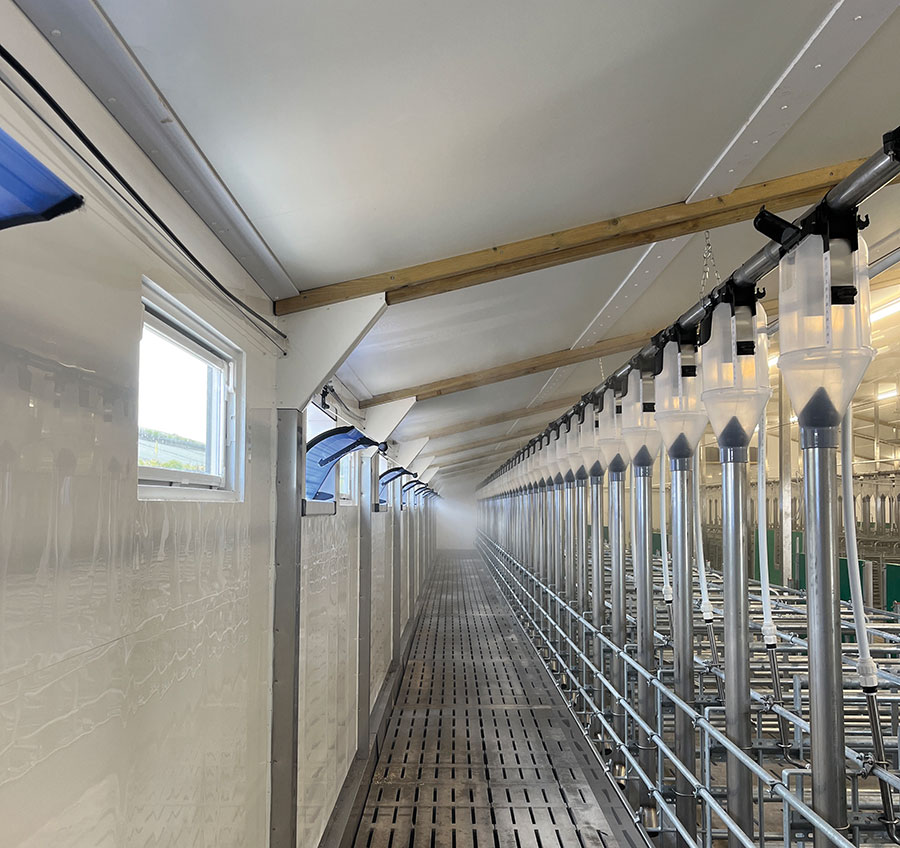The phrase ‘season of mists’ has been given a whole new meaning on some farms.
Whereas poet John Keats was referring to autumn, pig producers have been driven to install misting systems to cool sows in their farrowing houses due to successive summer heatwaves.
“Nearly every producer I speak to is asking about misting, and following a surge in enquiries, ARM Building has already installed several systems.
They are proving highly successful in reducing stress and improving the welfare of both sows and piglets,” said Tim Miller, the company’s environmental specialist.
Very fine mist
The high-pressure cooling systems are easy to install and reduce the temperature by a – sometimes life-saving – average of 6°C. A pump delivers water through a plastic pipeline, at 70 bar, to nozzles producing a very fine mist, which evaporates immediately and removes heat energy from the air.
The 20-micron nozzles, positioned in front of the air inlets to catch the incoming airflow, produce such a fine spray that they each use just four litres of water an hour and do not wet the fabric of the building.
“During the scorching weather experienced last summer, we had no issues on farms where the cooling system was in operation. We found owners were delighted and the staff loved to work in such buildings on hot days,” said Mr Miller.
On similar units without misting, sows had difficulty coping with heat stress, he explained.
Automated system
The system can be automated by linking it to the ventilation controls, and Mr Miller advises this to avoid any oversights during hot weather.
Farmex is working on a new programme that will enable Dicam control units to be upgraded in existing buildings.
In the past, some units have used low-pressure systems from the normal mains water supply, but these need about 25 litres per nozzle per hour– a huge daily amount – and wet the buildings significantly.
Having been widely used on the Continent, high-pressure systems are well proven and reliable. They are also easy to install and it can be done by farmers themselves.
The most expensive item is the pump, at about £1,500, and the total cost depends, to a large degree, on how many rooms it serves, the size and layout of the building and the number of inlets.
An installation last year involved two farrowing units on separate farms. Each pig unit had houses with four rooms, with 36 sows in each room. The cost in this case worked out at £35 a sow.
The owner judged this well worthwhile in terms of higher feed intake by the sows, heavier piglets and much improved welfare due to reduced heat stress on the sows.
“Many large units are installing misting systems as standard when erecting farrowing sheds,” said Mr Miller. “Grants are now available, though they seem to specify stainless steel piping, which is probably more expensive than plastic. However, the benefits are clear.
“One Spanish operator – where admittedly conditions tend to be harsher – said they routinely lose 26 days’ performance in their finishing sheds during hot weather.”
It is important to have a clean water supply with an efficient filtering system to avoid nozzle blockages. During times with high ambient humidity levels – above, say, 85% – the evaporative cooling is not as effective, but that can be monitored, Mr Miller added.
Although the system can be used in finishing houses, he sees the main benefits in British conditions to be in the farrowing rooms, since heavily pregnant sows and those that are suckling are very susceptible to heat stress. Houses with sows in late pregnancy should also be considered.




